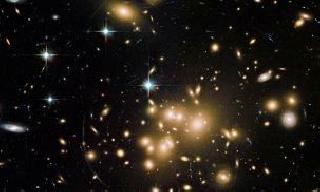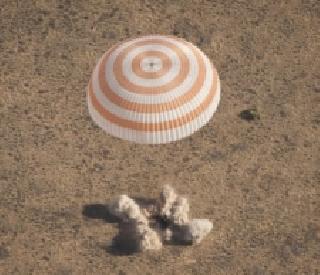
New Hubble image of galaxy cluster Abell 1689. A NASA/ESA Hubble photo
WASHINGTON (PTI): NASA's Hubble space telescope has discovered the largest known population of globular star clusters - an estimated 160,000 - more than two billion light years away from Earth.
The galaxies are swarming like bees inside the crowded core of the giant grouping of galaxies Abell 1689. By comparison, our Milky Way galaxy hosts about 150 such clusters.
The Hubble observations also confirm that these compact stellar groupings can be used as reliable tracers of the amount of dark matter locked away in immense galaxy clusters.
Globular clusters, dense bunches of hundreds of thousands of stars, are the homesteaders of galaxies, containing some of the oldest surviving stars in the Universe.
An international team of astronomers, led by John Blakeslee of the National Research Council, Herzberg Astrophysics Programme at the Dominion Astrophysical Observatory in Victoria, British Columbia, Canada, discovered a bounty of these stellar fossils, which is roughly twice as large as any other population found in previous globular cluster surveys.
The Hubble observations also win the distance record for the farthest such systems ever studied, at 2.25 billion light-years away, researchers said.
The research team found that the globular clusters are intimately intertwined with dark matter.
"In our study of Abell 1689, we show how the relationship between globular clusters and dark matter depends on the distance from centre of the galaxy grouping," said team member Karla Alamo-Martinez of the Centre for Radio Astronomy and Astrophysics of the National Autonomous University of Mexico in Morelia.
"In other words, if you know how many globular clusters are within a certain distance, we can give you an estimate of the amount of dark matter," said Alamo-Martinez.
The Hubble study shows that most of the globular clusters in Abell 1689 formed near the centre of the galaxy cluster, which contains a deep well of dark matter.
Their number decreases the farther away Hubble looked from the core, corresponding with a comparable drop in the amount of dark matter.
"The globular clusters are fossils of the earliest star formation in Abell 1689, and our work shows they were very efficient in forming in the denser regions of dark matter near the centre of the galaxy cluster," Blakeslee said.
The astronomers used Hubble's Advanced Camera for Surveys to peer deep inside the heart of Abell 1689, detecting the visible-light glow of 10,000 globular clusters, some as dim as 29th magnitude.
Based on that number, Blakeslee's team estimated that more than 160,000 globular clusters are huddled within a diameter of 2.4 million light-years.
The study appears in the The Astrophysical Journal.
 Previous Article
Previous Article













The Indian Air Force, in its flight trials evaluation report submitted before the Defence Ministry l..
view articleAn insight into the Medium Multi-Role Combat Aircraft competition...
view articleSky enthusiasts can now spot the International Space Station (ISS) commanded by Indian-American astr..
view article